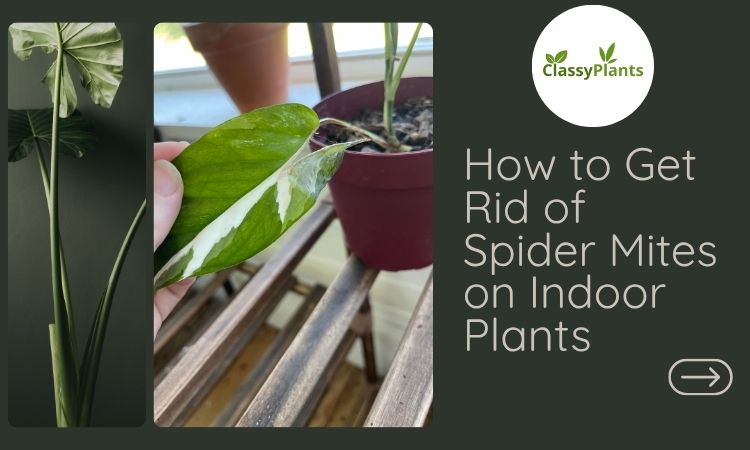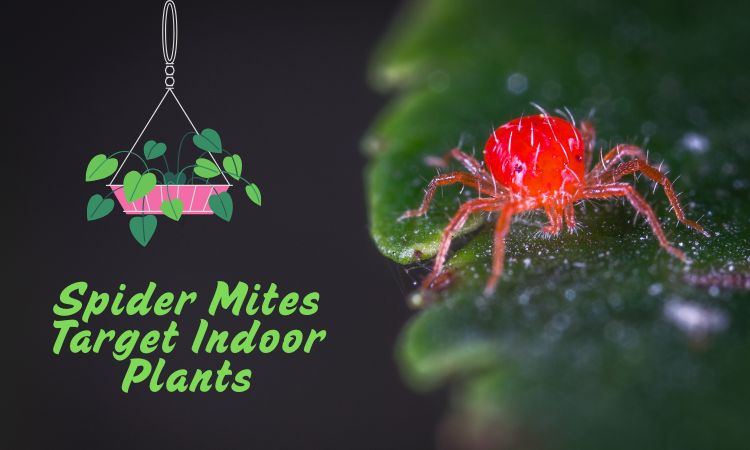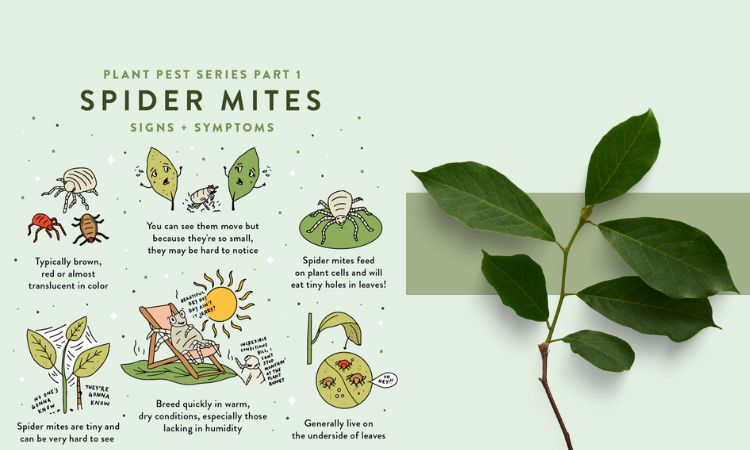Your indoor jungle, a vibrant pothos, a stately monstera, or a delicate fern brings life to your home. But one day, you notice tiny webs, speckled leaves, or wilting foliage. The culprit? Spider mites. These microscopic pests can wreak havoc on your houseplants, but don’t despair! Knowing how to get rid of spider mites on indoor plants is the key to restoring your green friends to their full glory. This comprehensive guide dives into the latest, research-backed methods to eliminate spider mites, offering practical, plant-safe solutions to keep your indoor plants thriving.

Understanding Spider Mites and Their Impact
Spider mites are tiny arachnids, barely visible to the naked eye, that feed on plant sap. They thrive in warm, dry conditions common in heated homes during winter. These pests can quickly multiply, causing significant damage if left unchecked. Signs of spider mite infestation include:
- Fine webbing on leaves or stems
- Yellow or white speckles (stippling) on leaves
- Wilting or drooping foliage
- Stunted growth or leaf drop
Left untreated, spider mites can weaken or even kill your indoor plants. Understanding how to get rid of spider mites on indoor plants starts with early detection and prompt action.
Why Spider Mites Target Indoor Plants
Indoor environments often provide the perfect conditions for spider mites: low humidity, warm temperatures, and a lack of natural predators. Common indoor plants like spider plants, peace lilies, and ficus are particularly susceptible. Factors that increase the risk include:
- Dry air: Central heating or lack of humidity creates an ideal habitat.
- Overcrowded plants: Close proximity allows mites to spread easily.
- Stressed plants: Weak or nutrient-deficient plants are more vulnerable.

Steps to Get Rid of Spider Mites on Indoor Plants
To effectively tackle spider mites, follow these proven steps. Each method is designed to be safe for your plants while targeting the pests.
1. Isolate the Affected Plant
As soon as you spot signs of spider mites, isolate the infested plant to prevent the pests from spreading to others. Place it in a separate room or cover it with a plastic bag during treatment.
2. Prune and Clean Affected Areas
- Remove damaged leaves: Use clean, sharp scissors to cut off heavily infested leaves. Dispose of them in a sealed bag to avoid spreading mites.
- Wipe leaves: Gently wipe both sides of the leaves with a damp cloth to remove mites and webs. For delicate plants, use a soft sponge.
3. Rinse the Plant
A strong stream of water can dislodge spider mites. Here’s how to do it safely:
- Shower or spray: Take the plant to a sink or shower and rinse the leaves with lukewarm water. Use a gentle spray bottle for smaller plants.
- Focus on undersides: Spider mites often hide on the underside of leaves, so target these areas.
- Repeat weekly: Regular rinsing can prevent re-infestation.
4. Increase Humidity
Spider mites hate high humidity. Boosting moisture levels can deter them:
- Mist regularly: Lightly mist your plants daily, especially in dry seasons.
- Use a humidifier: Aim for 50–60% humidity, ideal for most indoor plants.
- Group plants: Clustering plants creates a microclimate with higher humidity.
5. Apply Natural Remedies
Several plant-safe remedies can help eliminate spider mites:
- Neem oil: Mix 1 tsp of neem oil with 1 quart of water and a few drops of dish soap. Spray on leaves, focusing on undersides, every 5–7 days.
- Insecticidal soap: Use a pre-mixed solution or dilute 1 tbsp of mild liquid soap in 1 quart of water. Apply weekly, avoiding overuse to prevent leaf burn.
- Rubbing alcohol: Dab a cotton swab with 70% isopropyl alcohol and apply directly to infested areas. Test on a small leaf first to ensure safety.
| Remedy | Application | Frequency | Precautions |
|---|---|---|---|
| Neem oil | Spray diluted solution on leaves | Every 5–7 days | Avoid overuse; test on sensitive plants |
| Insecticidal soap | Spray or wipe on leaves | Weekly | Rinse after 1–2 hours to prevent buildup |
| Rubbing alcohol | Dab with cotton swab | As needed | Test on a small area first |
6. Introduce Beneficial Insects
For severe infestations, consider biological control:
- Predatory mites: Species like Phytoseiulus persimilis feed on spider mites. Purchase from reputable garden suppliers.
- Ladybugs: These natural predators can help control mite populations. Ensure your indoor environment supports these insects, as they require specific conditions to thrive.
7. Monitor and Repeat
Spider mite eggs can hatch in as little as 3–5 days, so persistence is key. Check your plant every few days and repeat treatments for 2–3 weeks to break the life cycle.

Preventing Spider Mite Infestations
Once you’ve mastered how to get rid of spider mites on indoor plants, prevention is crucial to avoid future issues. Follow these tips:
- Regular inspections: Check plants weekly for early signs of pests, especially on new or stressed plants.
- Maintain humidity: Keep humidity levels above 50% with a humidifier or pebble tray.
- Avoid overcrowding: Space plants to improve air circulation and reduce mite spread.
- Quarantine new plants: Isolate new plants for 2–3 weeks to ensure they’re pest-free.
- Clean regularly: Dust leaves to remove potential mite habitats and improve photosynthesis.
Common Mistakes to Avoid
When tackling spider mites, steer clear of these pitfalls:
- Ignoring early signs: Delaying treatment allows mites to multiply rapidly.
- Overusing chemicals: Excessive use of neem oil or soap can harm plants.
- Not treating all plants: Mites can spread to nearby plants, so check and treat all houseplants.
- Low humidity: Dry conditions encourage mite reproduction, so prioritize humidity.
Read More: Do You Need Nutrients After Repotting Indoor Plants
Long-Term Care for Healthy Indoor Plants
To keep your plants resilient against spider mites and other pests, adopt a holistic care routine:
- Watering: Avoid overwatering, as soggy soil can stress plants and make them more susceptible.
- Light: Provide appropriate light for each plant species to support healthy growth.
- Fertilizing: Use a balanced fertilizer (e.g., 10-10-10 NPK) during the growing season to strengthen plants.
- Pruning: Regularly trim dead or yellowing leaves to maintain plant health.

FAQs About How to Get Rid of Spider Mites on Indoor Plants
Look for fine webbing, yellow or white speckles on leaves, wilting, or stunted growth. Use a magnifying glass to spot tiny, moving dots on leaf undersides.
No, spider mites don’t harm humans or pets. They feed exclusively on plant sap but can cause significant damage to indoor plants.
Chemical pesticides can work but may harm delicate plants or indoor air quality. Natural remedies like neem oil or insecticidal soap are safer and effective.
With consistent treatment (e.g., rinsing, neem oil, or soap), you can eliminate spider mites in 2–3 weeks by targeting adults and eggs.
Yes, if eggs remain or conditions stay favorable (low humidity, dry air). Regular monitoring and preventive measures are essential.
Conclusion
Learning how to get rid of spider mites on indoor plants is a game-changer for any plant parent. By acting quickly with methods like rinsing, neem oil, or increasing humidity, you can eliminate these pests and protect your indoor jungle. Prevention is just as important, regular inspections, proper humidity, and plant care can keep spider mites at bay. With these expert tips, your indoor plants will stay healthy, vibrant, and free from pesky invaders, bringing beauty to your home for years to come.